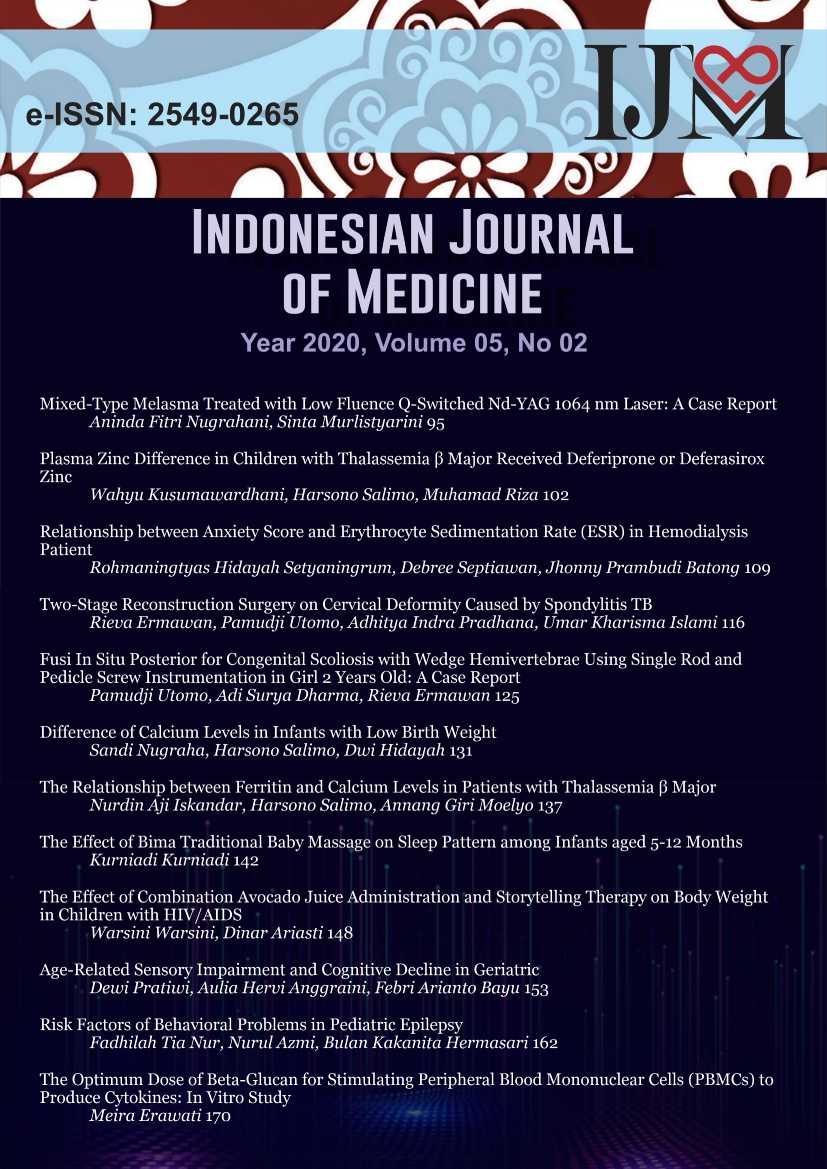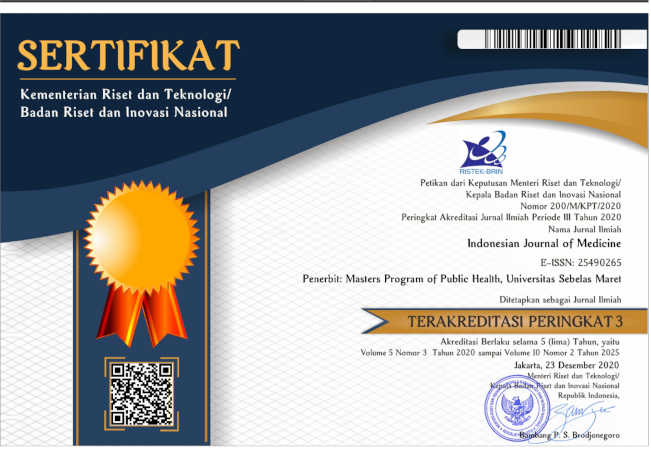Fusi In Situ Posterior for Congenital Scoliosis with Wedge Hemivertebrae Using Single Rod and Pedicle Screw Instrumentation in Girl 2 Years Old: A Case Report
DOI:
https://doi.org/10.26911/theijmed.2020.5.2.274Abstract
Background: Many spinal vertebral anomalies often occur, both scoliosis and kyfosis. In scoliosis, congenital abnormalities caused by hemivertebrae are the most common cause of abnormalities. The choice of treatment used can be either non-operative or operative. However, non-operative treatment does not show satisfactory results to prevent the development of deformity. Operative treatment is an option that is considered to indicate more satisfying results. A variety of procedures such as in-situ posterior or with or without instrumentation anteroposterior fusions, combined anterior and posterior convex hemiepiphysiodesis and hemiarthrodesis, and hemivertebral excision with fusion. Fusi In-situ posterior is a procedure option that is considered more beneficial for both surgeons and patients. This study aimed to evaluate the fusi in situ posterior for congenital scoliosis with wedge hemivertebrae using single rod and pedicle screw instrumentation in girl 2 year old.
Case Presentation: Girl 2 year old with wedge hemivertebrae operated with fusion in situ posterior using single rod and pedicle screw instrumentation.
Results: The operative treatment was performed on 2 hours operation time with amount of bleeding produced is 80 cc. There were no cranckshaft phenomena and no clinical and radological features suggestive of spinal stenosis. There were no major vascular or neurogical complications related to the pedicle screws. Then patient wore body jacket for limitation movement before fusion.
Conclusion: Posterior situ fusion is performed as convex fusion to avoid curve progression. Fusion in situ posterior using single rod and pedicle screw instrumentation. In congenital scoliosis is minimal blood loss, less traumatic, simple, safe and effective procedure. This study showed the early fusi in situ posterior of congenital scoliosis structural changes occur above or below can reduce fusion length, prevent curve progression and effectively achieve a more satisfactory correction without hazardous iatrogenic spinal stenosis, crankshaft phenomena, or neurological complications. Further research is needed to assess the progress of the outcome of surgery
Keywords: congenital scoliosis, wedge hemivertebrae, convex, fusi in situ posterior
Correspondence: Pamudji Utomo. Department of Orthopaedic & Traumatology, Faculty of Medicine, Universitas Sebelas Maret/ Prof. Dr. R. Soeharso Orthopaedic Hospital, Surakarta
Indonesian Journal of Medicine (2020), 05(02): 125-130
https://doi.org/10.26911/theijmed.2020.05.02.05
References
Bollini G, Docquier PL, Viehweger E, Launay F, Jouve JL (2006). Thoracolumbar hemivertebrae resection by double approach in a single procedure: longterm follow up. Spine (Phila Pa 1976). 31(15): 1745–1757. https://doi.org/10.1097/01.brs.0000224176.40457.52
Hedequist D, Emans J (2004). Congenital scoliosis. J Am Acad Orthop Surg. 12(4): 266-75. https://doi.org/10.5435/00124635200407000-00007.
Nakamura H, Matsuda H, Konishi S, Yamano Y (2002). Single stage excision of hemivertebrae via the posterior approach alone for congenital spine deformity: follow up period longer than ten years. Spine (Phila Pa 1976). 27(1): 110–115. https://doi.org/10.1097/00007632200201010-00026
Peng X, Chen L, Zou X (2011). Hemivertebra resection and scoliosis correction by a unilateral posterior approach using single rod and pedicle screw instrumentation in children under 5 years of age. J Pediatr Orthop B. 20(6): 397-403. https://doi.org/10.1097/BPB.0b013e3283492060
Ruf M, Harms J (2003). Posterior hemivertebra resection with transpedicular instrumentation: early correction in children aged 1 to 6 years. Spine (Phila Pa 1976). 28(18): 2132–2138. https://doi.org/10.1097/01.BRS.0000084627.57308.4A
Shono Y, Abumi K, Kaneda K (2001). Onestage posterior hemivertebra resection and correction using segmental posterior instrumentation. Spine (Phila Pa 1976). 26(7): 752–757. https://doi.org/10.1097/00007632200104010-00011.











